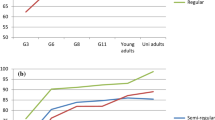Abstract
The relationship between comprehension of relational adjective forms and seriation ability was assessed for 60 children aged 4–6. Three groups, operational seriators, intuitive seriators, and nonseriators, were given a test measuring comprehension of affirmative and negative comparative and equative forms. Results indicated that operationals understood more forms than intuitives and that intuitives comprehended more than nonseriators. When age differences between groups were minimized, the latter but not the former difference was preserved. This suggests that significant growth in linguistic com[rehension accompanies the emergence of the ability to order objects by size. Analysis of errors indicated that nonseriators interpreted statements dichotomously and ignored the standard more than seriators. Findings help to clarify the relationship between linguistic and cognitive development for parallel underlying structures.
Similar content being viewed by others
References
Clark, E. V. (1972). On the child's acquisition of antonym pairs in two semantic fields.J. Verb. Learn. Verb. Behav. 11:750–758.
Clark, E. (1973). What's in a word? On the child's acquisition of semantics in his first language. In Moore, T. E. (ed.),Cognitive Development and the Acquisition of Language, Academic Press, New York.
Clark, H. (1969). Linguistic processes in deductive reasoning.Psychol. Rev. 76:387–404.
Clark, H. (1970). The primitive nature of children's relational concepts. In Hayes, J. R. (ed.),Cognition and the Development of Language, Wiley, New York.
Clark, H. (1973). Space, time, semantics and the child. In Moore, T. E. (ed.),Cognitive Development and the Acquisition of Language, Academic Press, New York.
Donaldson, M., and Balfour, G. (1968). Less is more: A study of language comprehension in children.Br. J. Psychol. 59:461–472.
Donaldson, M., and Wales, R. J. (1970). On the acquisition of some relational terms. In Hayes, J. R. (ed.),Cognition and the Development of Language, Wiley, New York.
Ehri, L. C. (1976). Comprehension and production of adjectives and seriation.J. Child Lang. 3:369–384.
Elkind, D. (1964). Discrimination, seriation and numeracion of size and dimensional differences in young children: Piaget replication study VI.J. Genet. Psychol. 104:275–296.
Farnham-Diggory, S., and Bermon, M. (1968). Verbal compensation, cognitive synthesis, and conservation.Merrill-Palmer Q. 14:215–227.
Inhelder, B., and Piaget, J. (1964).The Early Growth of Logic in the Child. Humanities Press, New York. In French: Piaget, J., and Inhelder, B. (1959).La Genèse des Structures Logiques Elemenaitres, Delachaux et Niestlé, Neuchâtel.
Inhelder, B., Bovet, M., Sinclair H., and Smock, C. D. (1966). On cognitive development.Am. Psychol. 21:160–164.
Klatzky, R. L., Clark, E., and Macken, M. (1973). Asymmetries in the acquisition of polar adjectives: Linguistic or conceptual?J. Exp. Child Psychol. 16:32–46.
Nelson, K., and Benedict, H. (1974). The comprehension of relative, absolute, and contrastive adjectives by young children.J. Psycholing. Res. 3:333–342.
Palermo, D. S. (1973). More about less: A study of language comprehension.J. Verb. Learn. Verb. Behav. 12:211–221.
Peisach, E. (1973). Relationship between knowledge and use of dimensional language and achievement of conservation.Dev. Psychol. 9:189–197.
Piaget, J. (1964). Cognitive development in children: The Piaget papers. In Ripple, R. E., and Rockcastel, V. N. (eds.),Piaget Rediscovered, School of Education, Cornell University, Ithaca, N.Y.
Piaget, J., and Inhelder, B. (1969).The Psychology of the Child, Basic Books, New York.
Piaget, J., and Inhelder, B. (1973).Memory and Intelligence, Routledge and Kegan Paul, London.
Rohwer, W. D. Jr., Ammon, P. R., and Cramer, P. (1974).Understanding Intellectual Development, Dryden Press, Hinsdale, Ill.
Sinclair de Zwart, H. (1967).Acquisition du Language et Developement de la Pensee, Dunod, Paris.
Sinclair de Zwart, H. (1969). Developmental psycholinguistics. In Elkind, D., and Flavell, J. H. (eds.),Studies in Cognitive Development, Oxford University Press, New York.
Townsend, D. J. (1974). Children's comprehension of comparative forms.J. Exp. Child Psychol. 18:293–303.
Wales, R. J., and Campbell, R. (1970). On the development of comparison and the comparison of development. In Flores d'Arcais, G. B., and Levelt, W. J. M. (eds.),Advances in Psycholinguistics, North-Holland, Amsterdam.
Walker, H. M., and Lev, J. (1953).Statistical Inference, Holt, Rinehart and Winston, New York.
Author information
Authors and Affiliations
Rights and permissions
About this article
Cite this article
Shaffer, T.M., Ehri, L.C. Seriators' and nonseriators' comprehension of comparative adjective forms. J Psycholinguist Res 9, 187–204 (1980). https://doi.org/10.1007/BF01067470
Received:
Issue Date:
DOI: https://doi.org/10.1007/BF01067470




